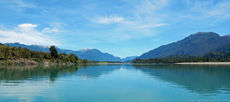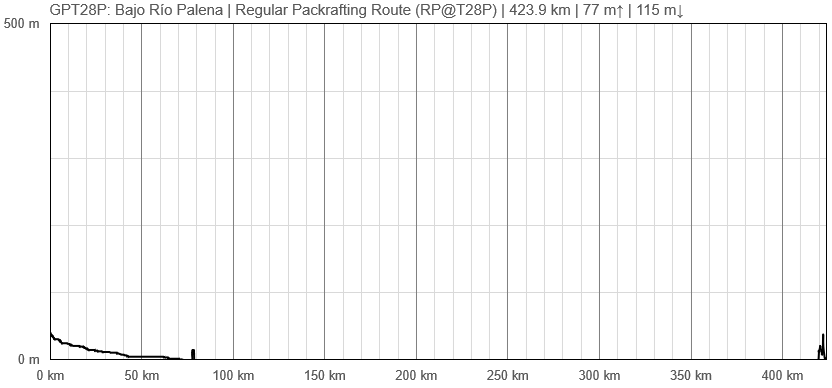GPT28P - Bajo Río Palena
| All GPT sections (click to show) |
|---|
|
GPT Section Articles
|
Recent Alerts and Suggestions
Season Section Log
- GPT28P / Exploration Fjord Pitipalena (Part of Option 2) / 2019-11-14 / 3 days / Meylin Ubilla & Jan Dudeck
We packrafted in the last 3 days the Fjord Pitipalena from Raul Marin Balmaceda (Puerto Marin or RMB) to the northern terminus of Brazo Pillan (Point B of attached map) and returned in two days back to Puerto Marin.
In the fjord sightings of penguins, sea lions and dolphins are frequent.
Tidal flows can reach in some parts 4 km/h but typically do not exceed 1 km/h.
As in all open waters wind and waves can be fierce but calm days are not uncommon due to the protection of the surrounding mountains. Be prepared to sit out days of bad weather in one of the few sheltered areas on the coast. We spend one night hanging in the trees with torrential rain and heavy gusty wind. On the last km back we were fighting heavy gusts of wind to return back to the village.
Meeting Rodrigo Parra was one highlight of this tour. He is the last settlers outside of Puerto Marin in this fjord. Location see image.
Decades ago this fjord was well populated with hundreds of settlers living at various shores of this fjord to harvest algae and some settlers attempted to grow cattle. All but one settler retreated and nature wiped out virtually all traces of these settlements.
We also investigated the area between the northern terminus of Brazo Pillan and Rio TicToc. Decades ago an well established trail crossed this 1.3 km land connection but this trail disappeared in most parts and is overgrown by dense but not impassable forest. I covered about 450 m in 1.5 hours noticing parts of an old trail or simply the machete battle field of packrafters or kayakers in this dense forest. This route to Rio TicToc is still occasionally taken by highly experienced sea kajakers or packrafters to access Parque Corcovado.
The exploration route from Rio TioTic to Chaiten follows the very exposed coast of the Golfo Corcovado. To cover the approximately 80 km from the mouth of Rio TicToc to Chaiten it needs plenty of sea-traveling experience, lots of patience and plenty of food to spend most of the time waiting for the occasional good-weather-window. I’m not sure if I better remove this route from the GPT network as a packraft traverse seams currently pretty fooled to me. I at least, have currently no desire to explore this route in the next years.
Summary Table
Satellite Image Map
Elevation Profile
Elevation Profile of Regular Packrafting Route
Section Planning Status
Recommended Travel Period
Benefits of Hiking and Packrafting
Recommended Travel Direction
Section Length and Travel Duration
Suitable Section Combinations
Section Attractiveness
Section Difficulty
Resupply
Resupply Town
Shopping: Food
Shopping: Fuel
Shopping: Equipment
Services: Restaurants
Services: Laundry
Services: ATM and Money Exchange
Accommodation: Hostals and Hotels
Accommodation: Cabañas
Accommodation: Camping
Transport: Ground Transport
Transport: Ferries
Transport: Shipping Services
Resupply on the Trail
Location, Names, Available Items and Services
Access to Route and Return
Access to Start
Return from Finish
Escape Options
Permits, Entry Fees and Right-of-Way Issues
Regular Route
Regular Hiking Route
Regular Packrafting Route
- Route description by Kara Davis after Season 2017/18:
Río Palena continues to steadily grow as it makes its way towards the ocean. This section has noticeably fewer rapids, and mostly consists of calm, slow moving water. Camping is abundant and easy to find. There are many rocky beaches that lead to flat grassy or sandy land. Within 20 km or so from the ocean, tidal effects on the river current are noticeable. Check a tidal timetable before embarking to get an idea of good times to paddle. If the wind or tides makes paddling impracticable, it is possible to reach Ruta X-12, a dirt road which follows the river and leads to Puerto Raúl Marín Balmaceda.
Notes for Travel to Puerto Chacabuco (Beginning of GPT29P): There are two options for transportation to Puerto Chacabuco:
1. Ferry
Book your tickets on the ferry from Puerto R.M. Balmaceda to Puerto Chacabuco in advance here: http://www.navieraustral.cl/itinerarios-y-tarifas
The ferry is a popular travel option and only runs a couple days during the week. It is also possible to purchase tickets at the local grocery store, but be prepared to wait for several days if you decide to do this.
2. Three Buses and a Taxi
There is also an option to take a series of shuttles to Puerto Chacabuco. This is a cheaper but certainly less enjoyable and more time consuming option. The series of shuttles required to get from Puerto R.M. Balmaceda to Puerto Chacabuco are as follows:
a. There is a van that runs from Puerto R.M. Balmaceda to La Junta twice a day which leaves from the ferry port (trip time ~3 hours). The tourist information station in Puerto R.M. Balmaceda can give you times and details about tickets.
b. From La Junta, there's a bus to Coyhaique that usually only runs once a day (trip time ~5 hours). Tickets may be bought before hand at the local depot (ask the tourist information center for directions). One company that offers transportation by bus from La Junta to Coyhaique is Aguilas Patagónicas. See their website here: http://www.aguilaspatagonicas.cl.
c. From Coyhaique, catch one of the many buses traveling to Puerto Aysen.
d. The final step is to hire a taxi (about 500 CLP) to Puerto Chacabuco. There is a pickup/dropoff location along highway 240 just outside of the Unimart.
Town: Puerto Raúl Marín (R.M.) Balmaceda
Puerto R.M. Balmaceda has a few lodging options and lots of open ground for camping. There are a couple of expensive markets that could meet resupply needs, but Coyhaique or Puerto Aysen definitely have better options.







